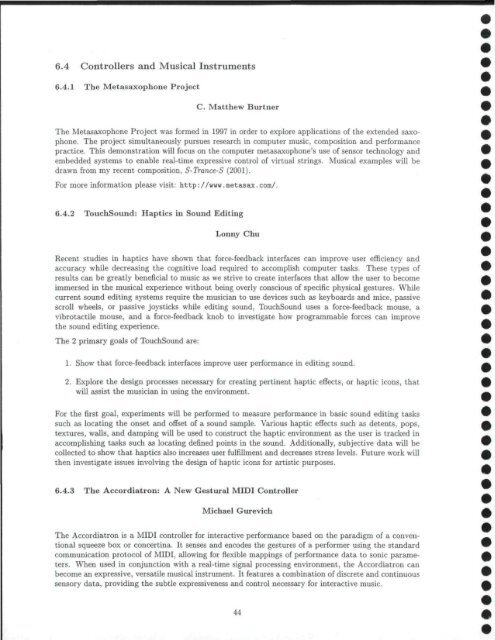CCRMA OVERVIEW - CCRMA - Stanford University
CCRMA OVERVIEW - CCRMA - Stanford University
CCRMA OVERVIEW - CCRMA - Stanford University
Create successful ePaper yourself
Turn your PDF publications into a flip-book with our unique Google optimized e-Paper software.
6.4 Controllers and Musical Instruments<br />
6.4.1 The Metasaxophone Project<br />
C. Matthew Burtner<br />
The Metasaxophone Project was formed in 1997 in order to explore applications of the extended saxophone.<br />
The project simultaneously pursues research in computer music, composition and performance<br />
practice. This demonstration will focus on the computer metasaxophone's use of sensor technology and<br />
embedded systems to enable real-time expressive control of virtual strings. Musical examples will be<br />
drawn from my recent composition, S-Trance-S (2001).<br />
For more information please visit: http://wwH.metasax.com/.<br />
6.4.2 TouchSound: Haptics in Sound Editing<br />
Lonny Chu<br />
Recent studies in haptics have shown that force-feedback interfaces can improve user efficiency and<br />
accuracy while decreasing the cognitive load required to accomplish computer tasks. These types of<br />
results can be greatly beneficial to music as we strive to create interfaces that allow the user to become<br />
immersed in the musical experience without being overly conscious of specific physical gestures. While<br />
current sound editing systems require the musician to use devices such as keyboards and mice, passive<br />
scroll wheels, or passive joysticks while editing sound, TouchSound uses a force-feedback mouse, a<br />
vibrotactile mouse, and a force-feedback knob to investigate how programmable forces can improve<br />
the sound editing experience.<br />
The 2 primary goals of TouchSound are:<br />
1. Show that force-feedback interfaces improve user performance in editing sound.<br />
2. Explore the design processes necessary for creating pertinent haptic effects, or haptic icons, that<br />
will assist the musician in using the environment.<br />
For the first goal, experiments will be performed to measure performance in basic sound editing tasks<br />
such as locating the onset and offset of a sound sample. Various haptic effects such as detents, pops,<br />
textures, walls, and damping will be used to construct the haptic environment as the user is tracked in<br />
accomplishing tasks such as locating defined points in the sound. Additionally, subjective data will be<br />
collected to show that haptics also increases user fulfillment and decreases stress levels. Future work will<br />
then investigate issues involving the design of haptic icons for artistic purposes.<br />
6.4.3 The Accordiatron: A New Gestural MIDI Controller<br />
Michael Gurevich<br />
The Accordiatron is a MIDI controller for interactive performance based on the paradigm of a conventional<br />
squeeze box or concertina. It senses and encodes the gestures of a performer using the standard<br />
communication protocol of MIDI, allowing for flexible mappings of performance data to sonic parameters.<br />
When used in conjunction with a real-time signal processing environment, the Accordiatron can<br />
become an expressive, versatile musical instrument. It features a combination of discrete and continuous<br />
sensory data, providing the subtle expressiveness and control necessary for interactive music.<br />
44

















